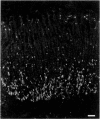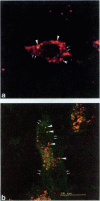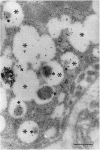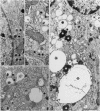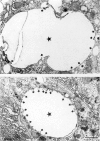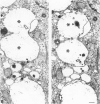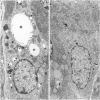Abstract
Using immunohistochemistry at the conventional light, confocal and electron microscopic levels, we have demonstrated that rat stomach ECL cells store histamine and pancreastatin in granules and secretory vesicles, while histidine decarboxylase occurs in the cytosol. Furthermore the ECL cells display immunoreactivity for vesicular monoamine transporter type 2 (VMAT-2), synaptophysin, synaptotagmin III, vesicle-associated membrane protein-2, cysteine string protein, synaptosomal-associated protein of 25 kDa, syntaxin and Munc-18. Using electron microscopy in combination with stereological methods, we have evidence to suggest the existence of both an exocytotic and a crinophagic pathway in the ECL cells. The process of exocytosis in the ECL cells seems to involve a class of proteins that promote or participate in the fusion between the granule/vesicle membrane and the plasma membrane. The granules take up histamine by VMAT-2 from the cytosol during transport from the Golgi zone to the more peripheral parts of the cells. As a result, they turn into secretory vesicles. As a consequence of stimulation (e.g., by gastrin), the secretory vesicles fuse with the cell membrane to release their contents by exocytosis. The crinophagic pathway was studied in hypergastrinemic rats. In the ECL cells of such animals, the secretory vesicles were found to fuse not only with the cell membrane but also with each other to form vacuoles. Subsequent lysosomal degradation of the vacuoles and their contents resulted in the development of lipofuscin bodies.
Full text
PDF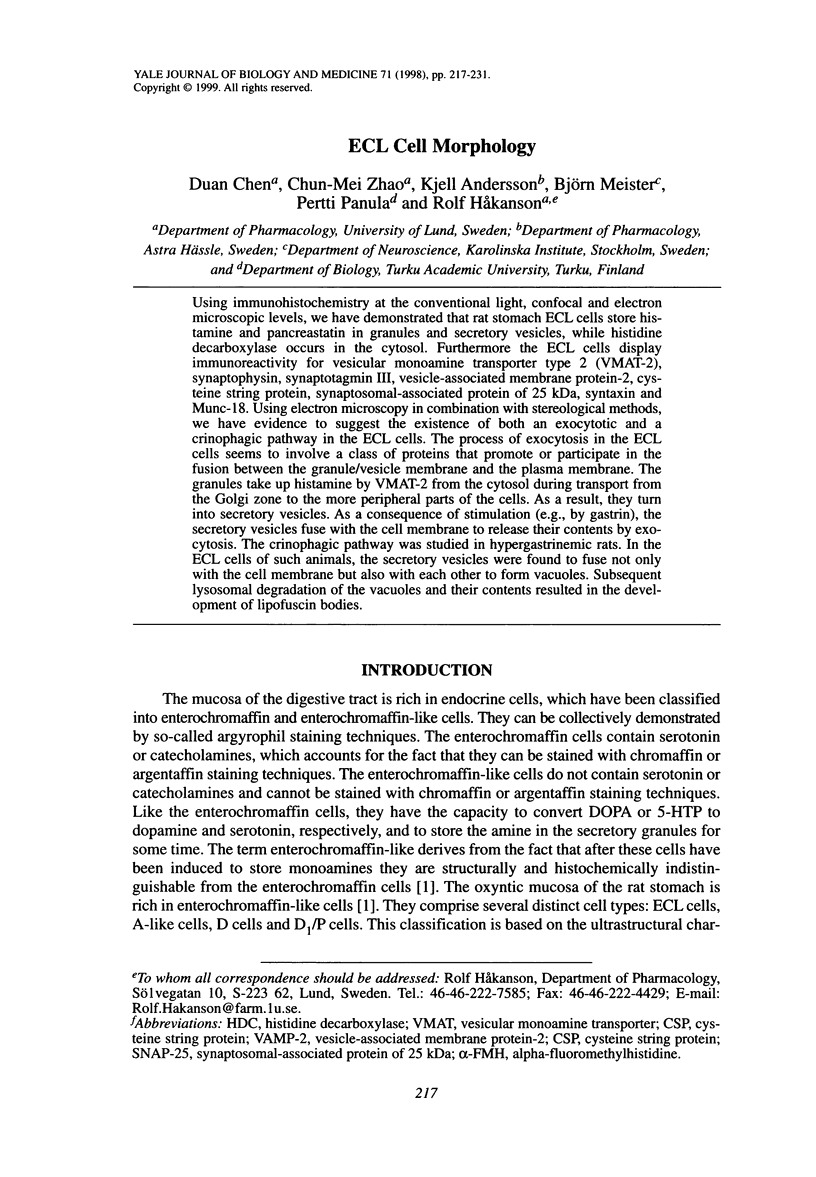
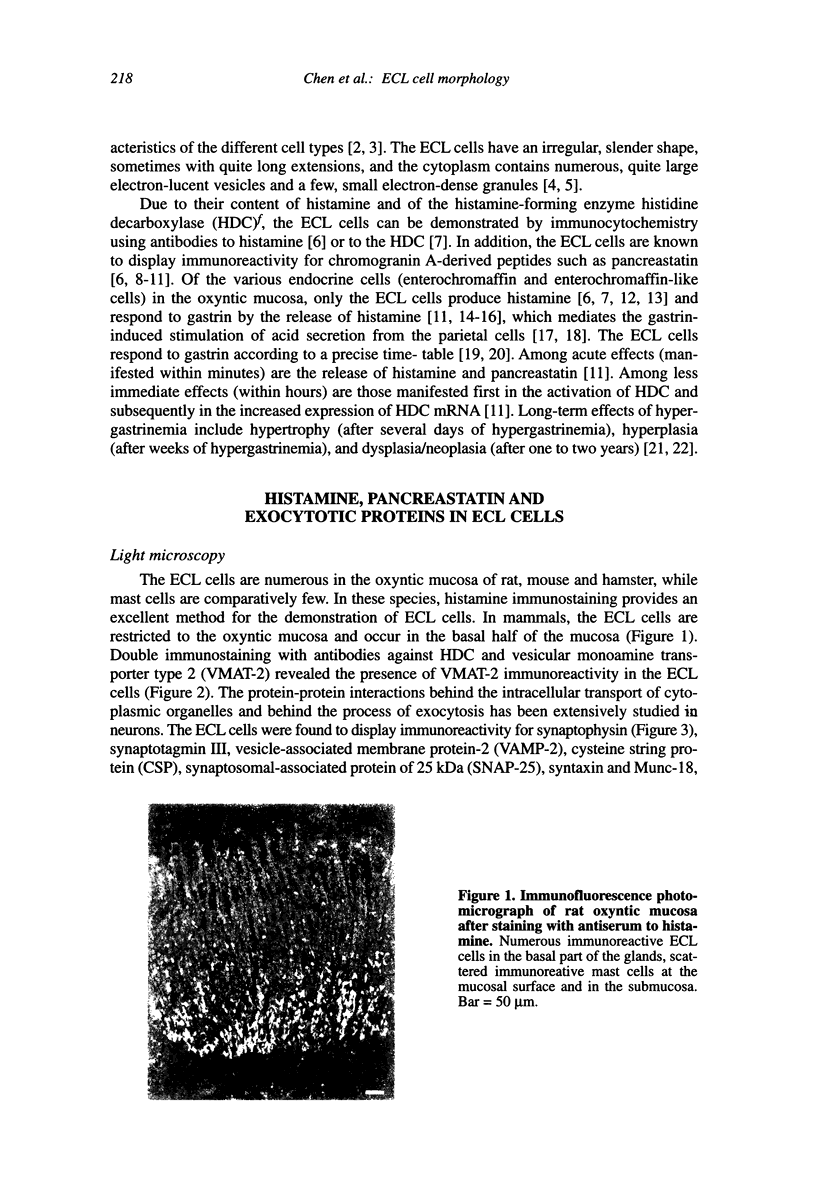
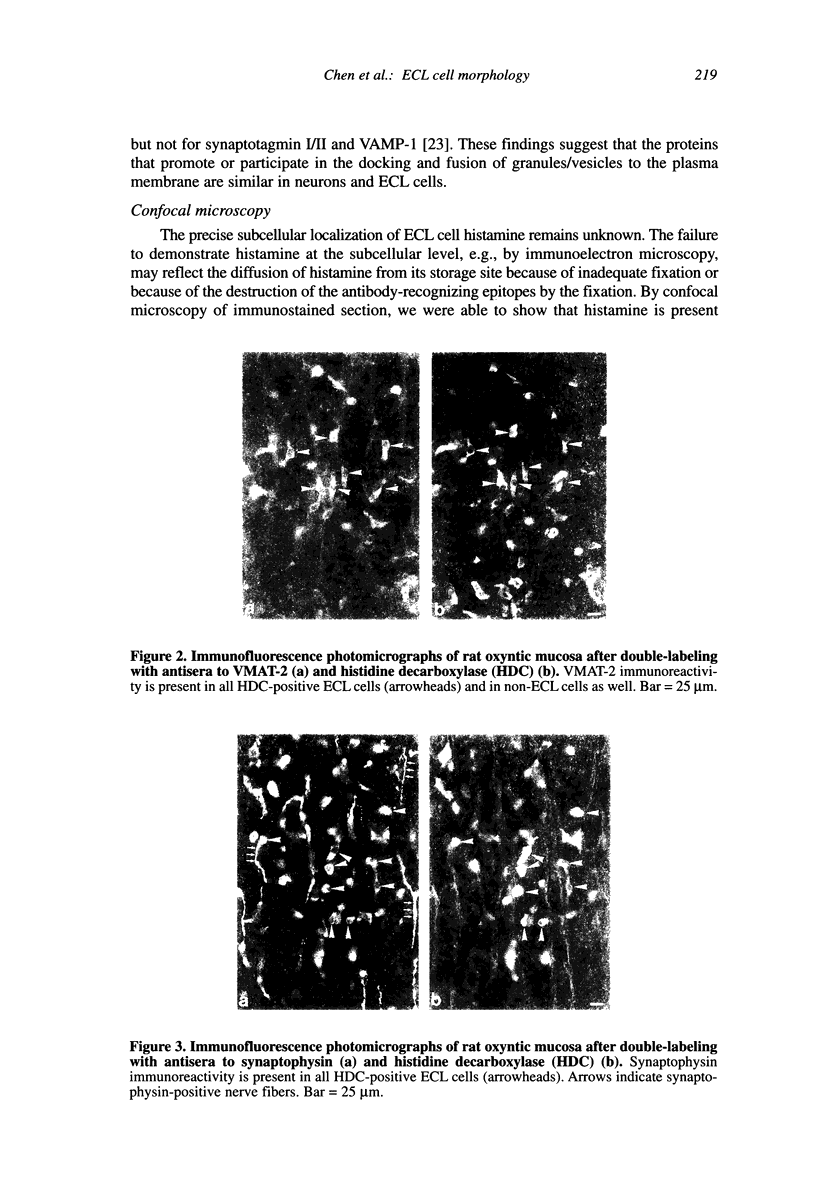
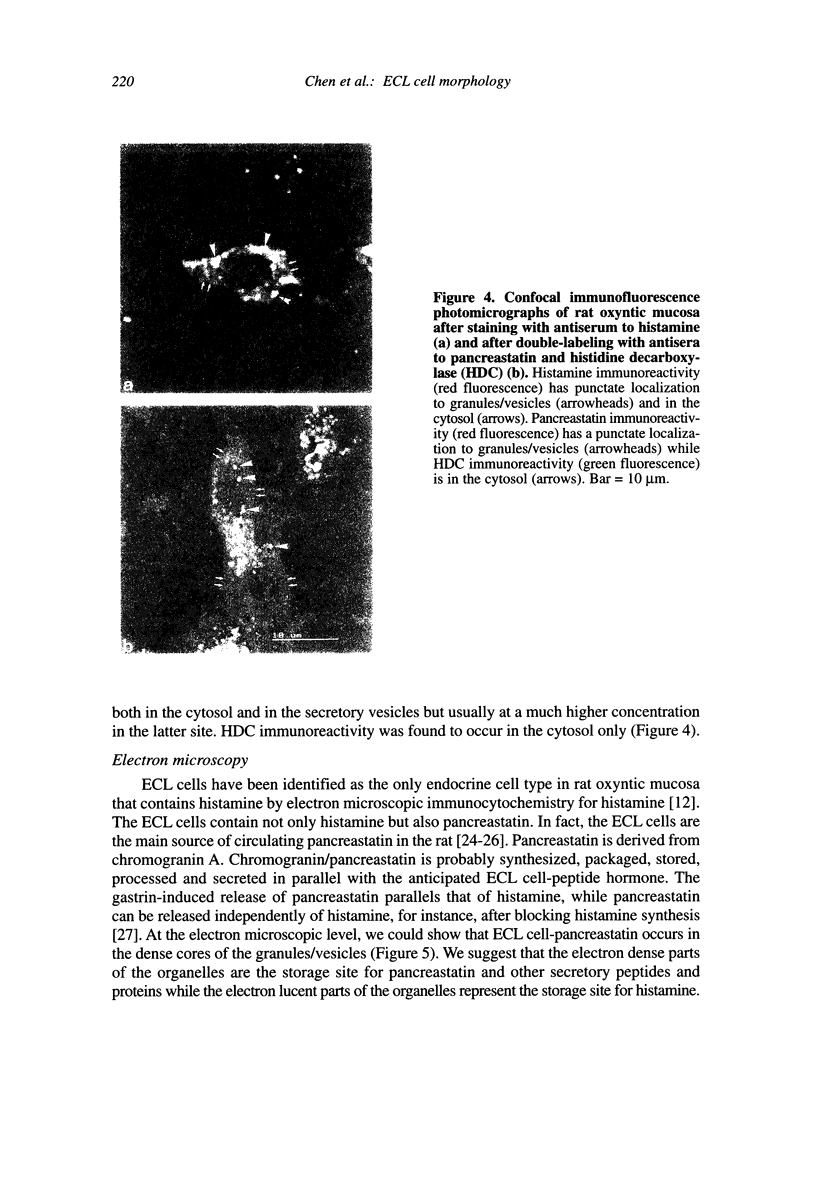
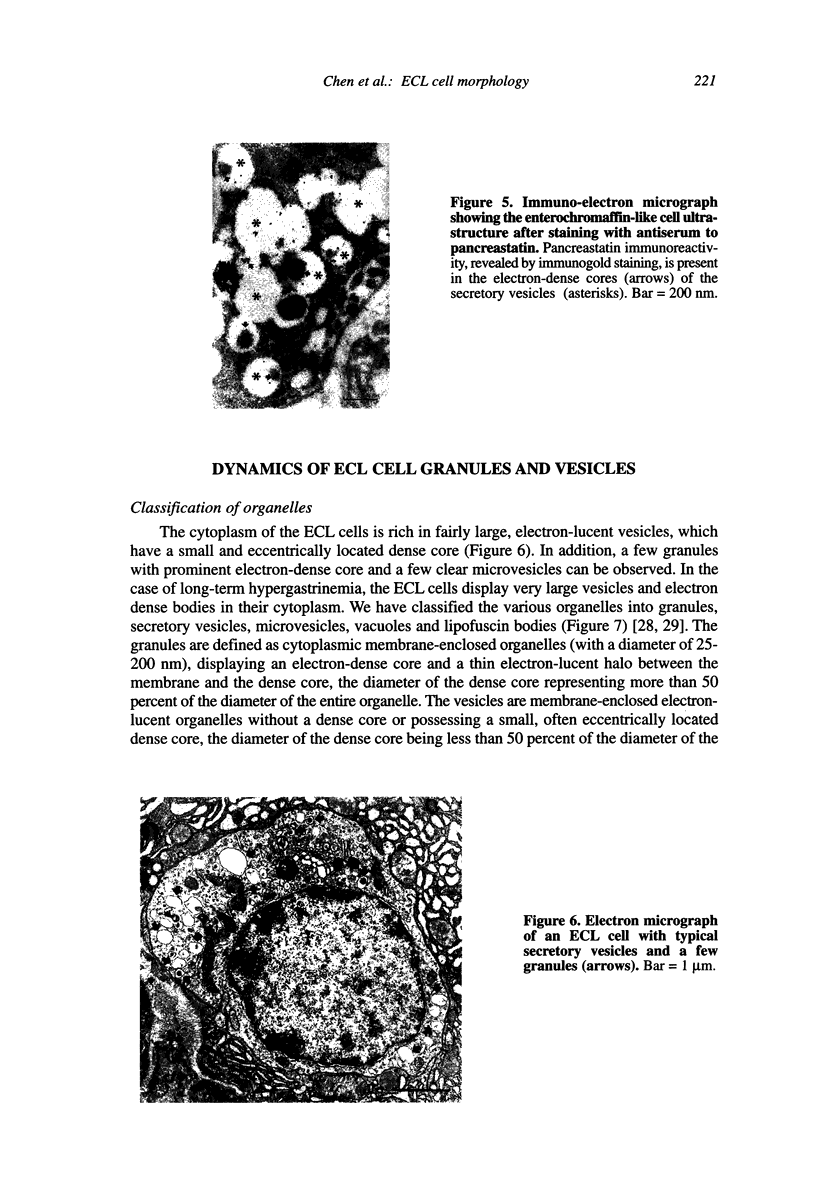
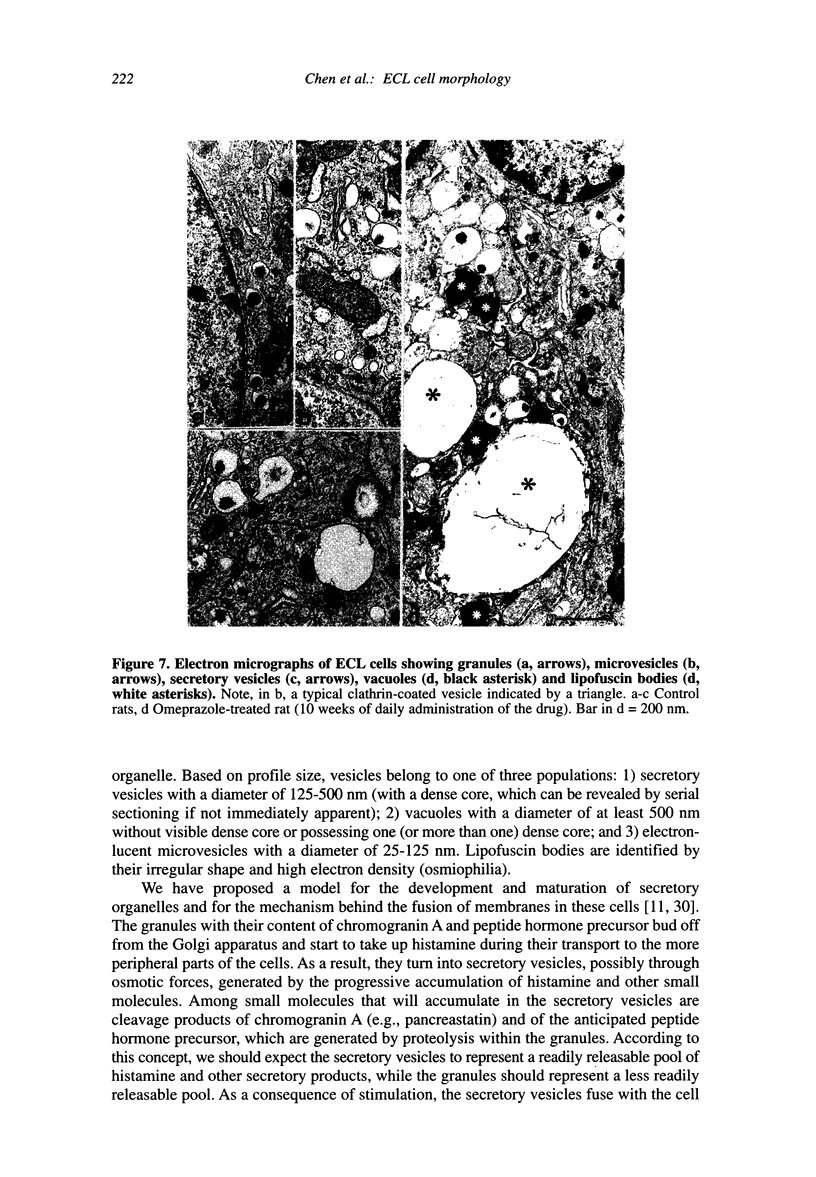
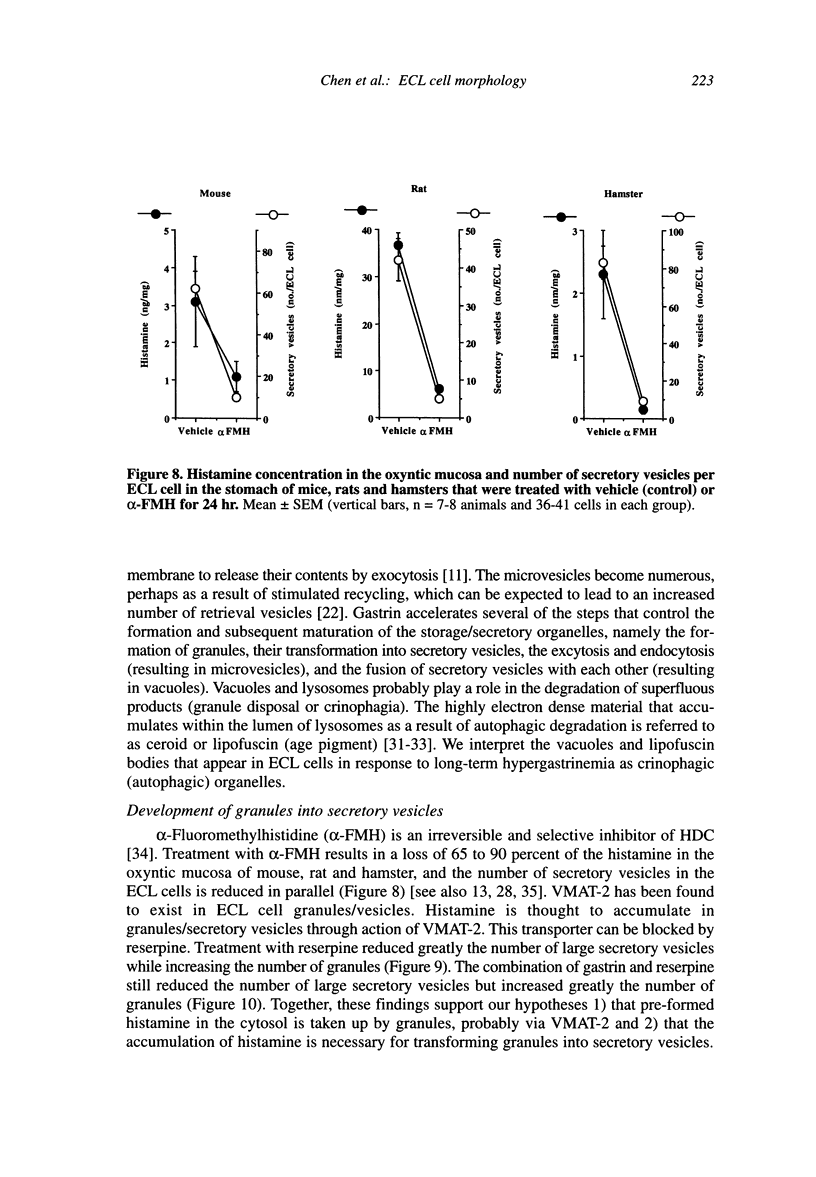
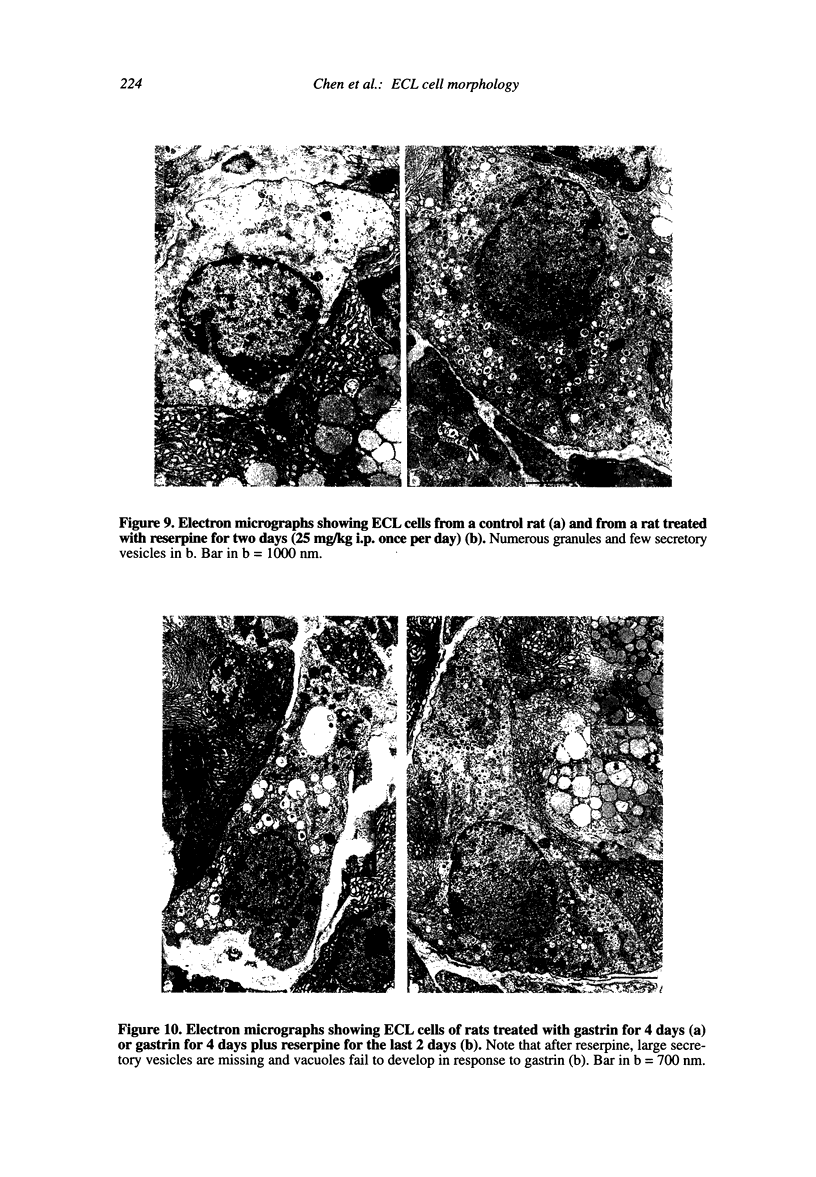
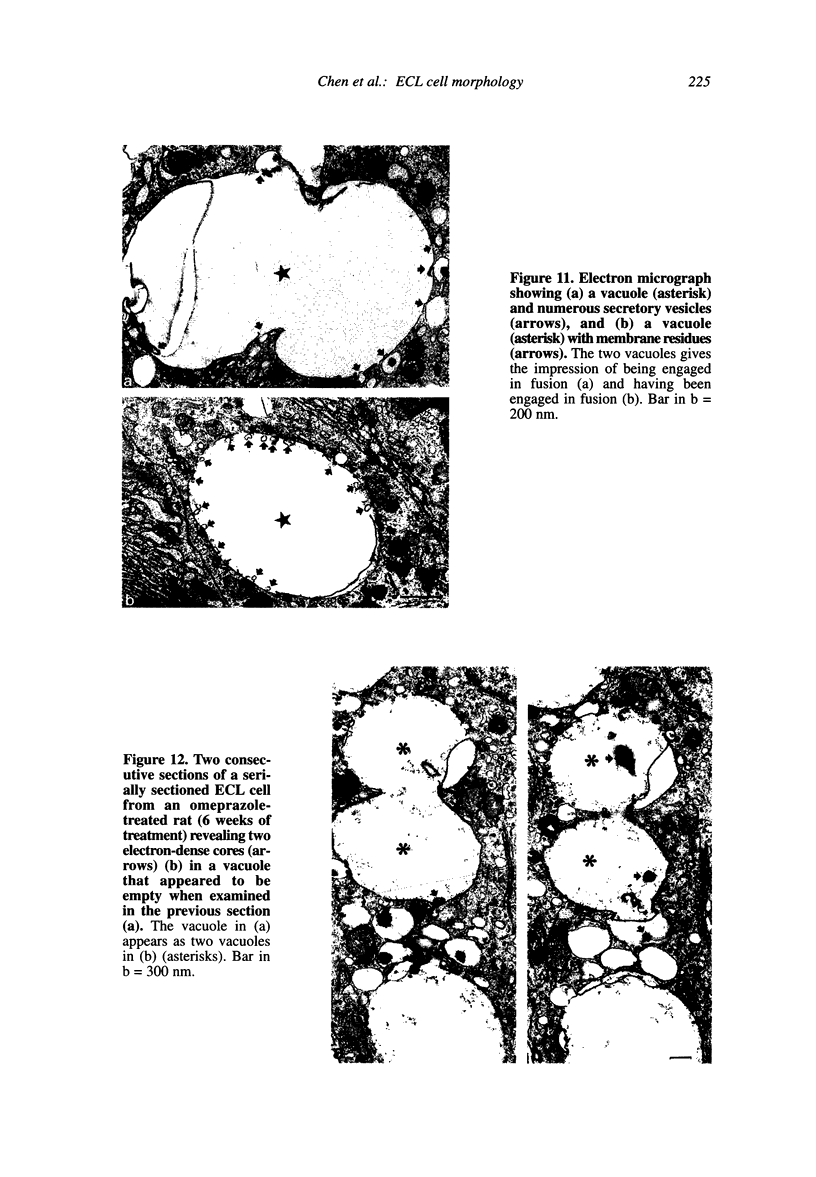
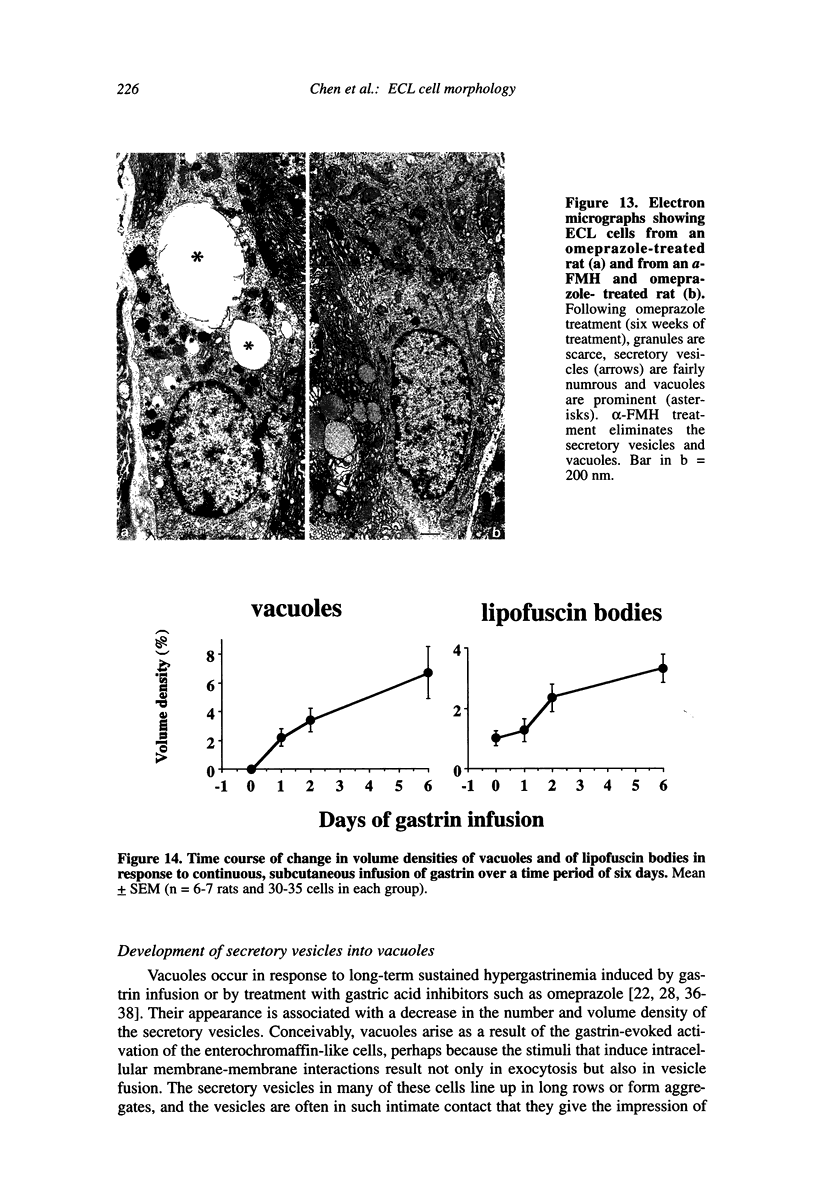
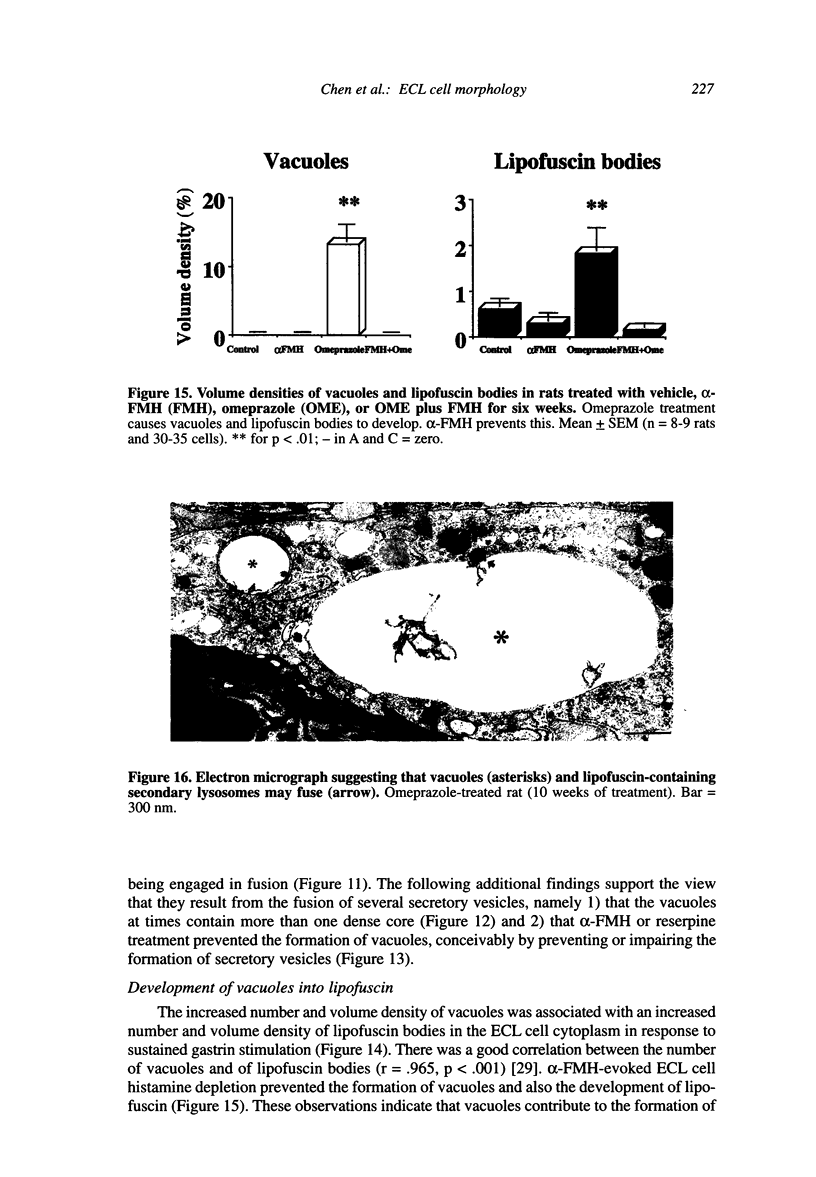
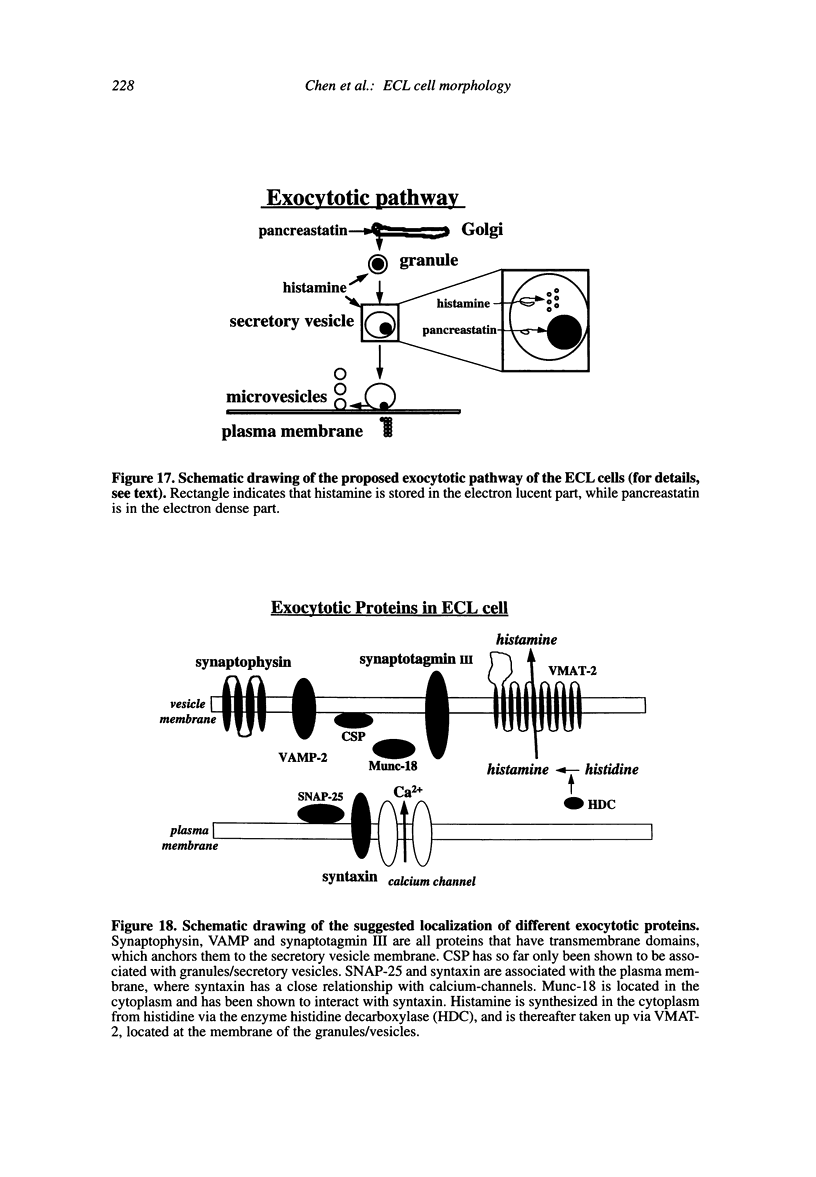
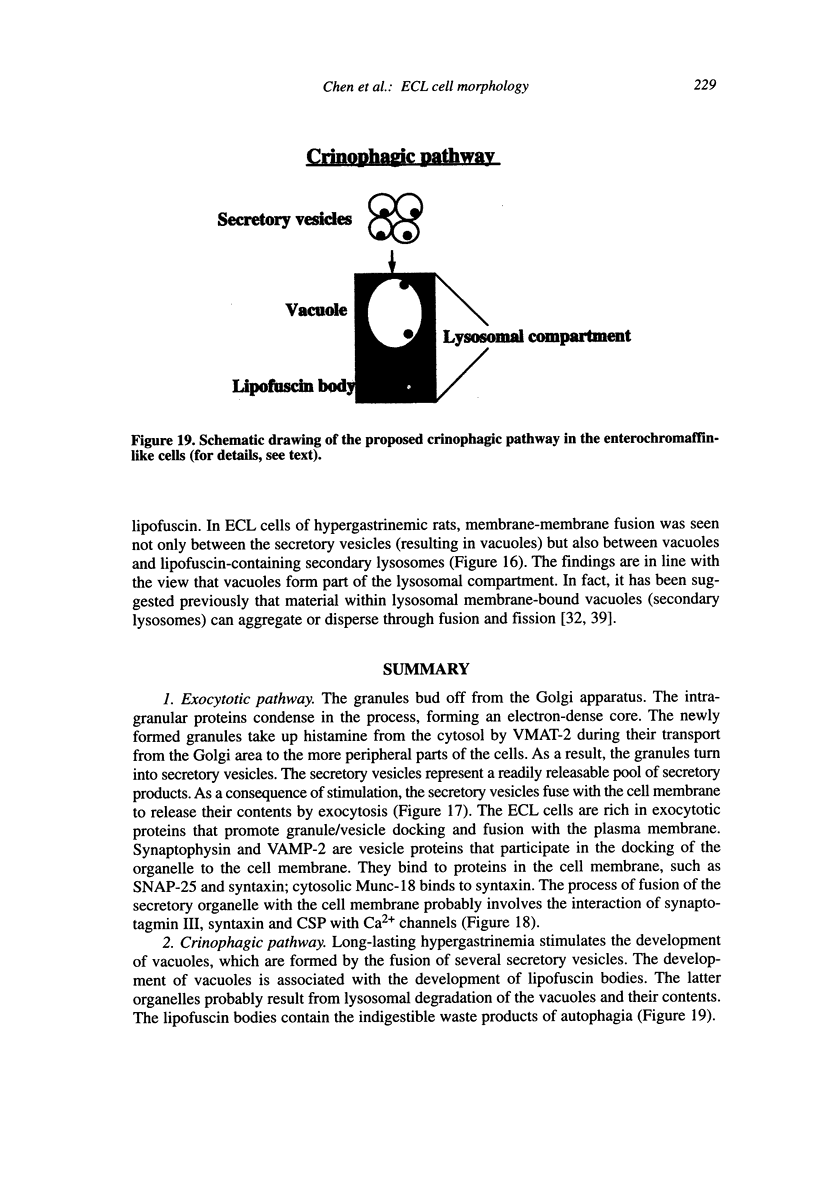
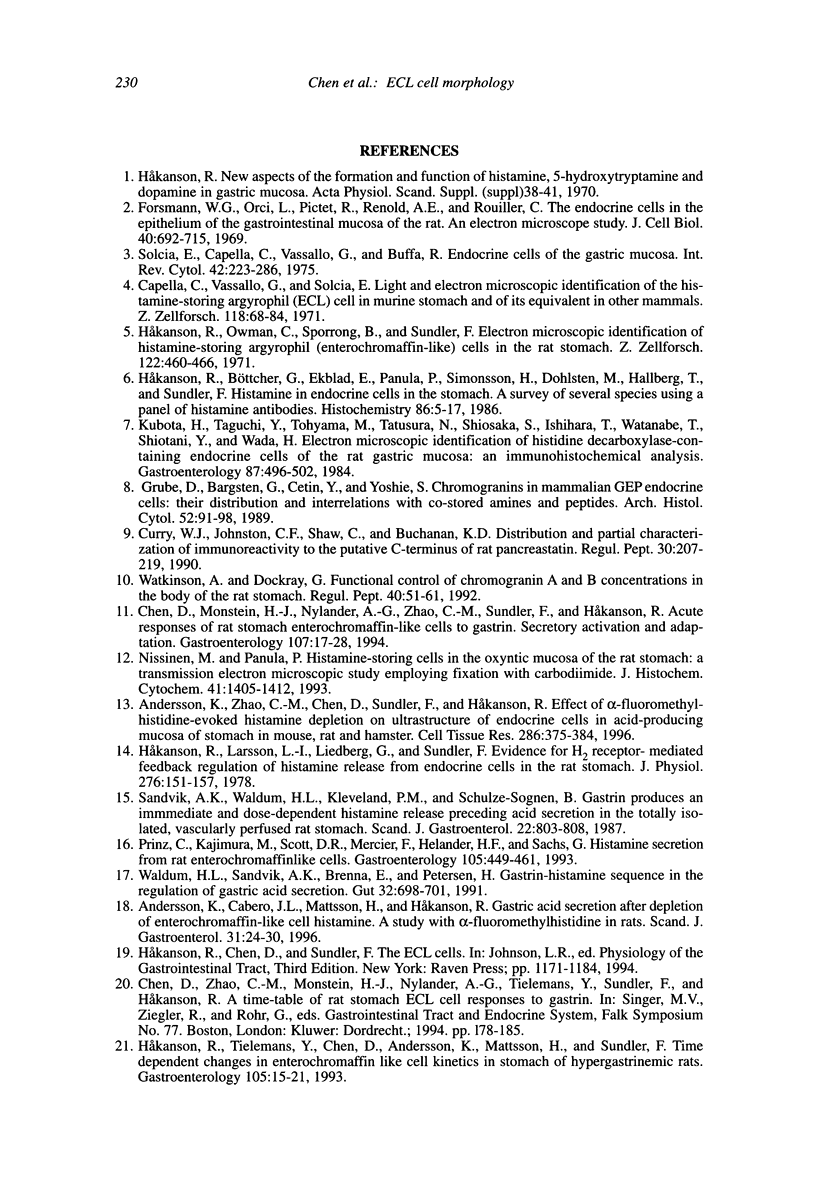
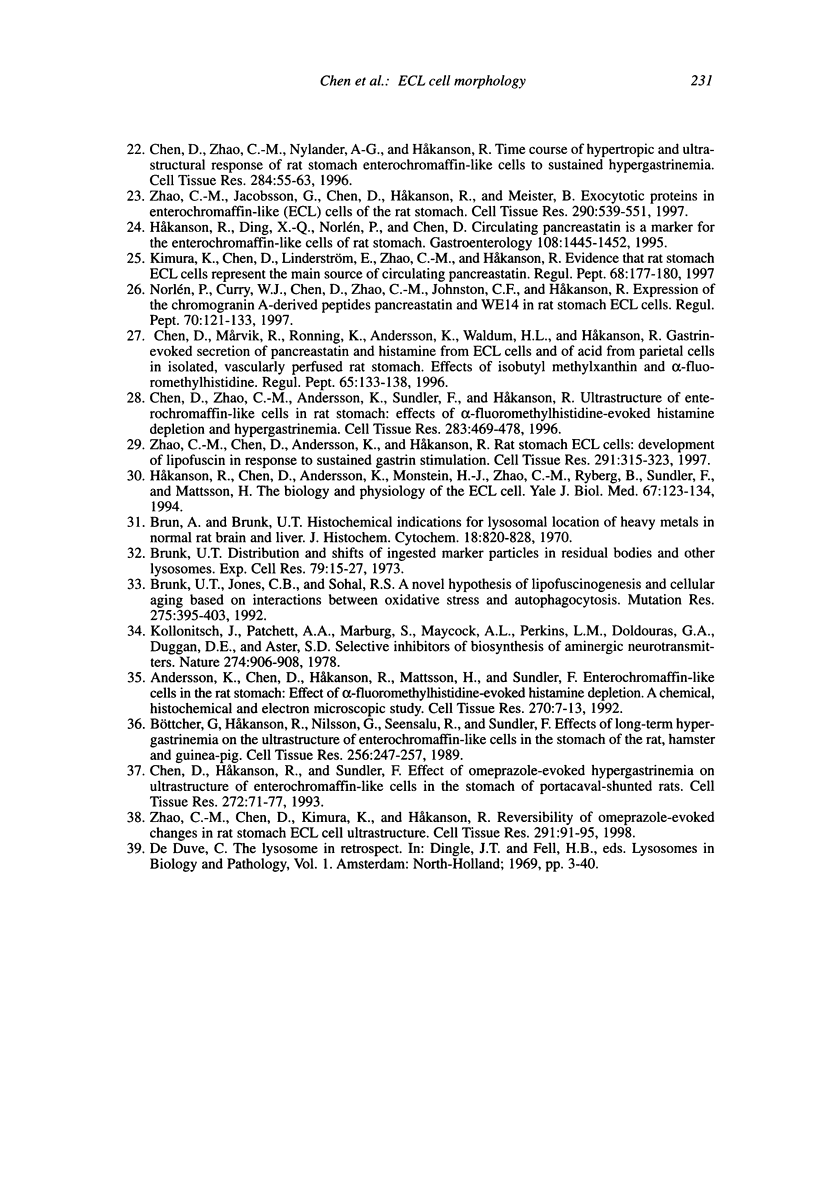
Images in this article
Selected References
These references are in PubMed. This may not be the complete list of references from this article.
- Andersson K., Cabero J. L., Mattsson H., Håkanson R. Gastric acid secretion after depletion of enterochromaffin-like cell histamine. A study with alpha-fluoromethylhistidine in rats. Scand J Gastroenterol. 1996 Jan;31(1):24–30. doi: 10.3109/00365529609031622. [DOI] [PubMed] [Google Scholar]
- Andersson K., Chen D., Håkanson R., Mattsson H., Sundler F. Enterochromaffin-like cells in the rat stomach: effect of alpha-fluoromethylhistidine-evoked histamine depletion. A chemical, histochemical and electron-microscopic study. Cell Tissue Res. 1992 Oct;270(1):7–13. doi: 10.1007/BF00381874. [DOI] [PubMed] [Google Scholar]
- Andersson K., Zhao C. M., Chen D., Sundler F., Hâkanson R. Effect of alpha-fluoromethylhistidine-evoked histamine depletion on ultrastructure of endocrine cells in acid-producing mucosa of stomach in mouse, rat and hamster. Cell Tissue Res. 1996 Dec;286(3):375–384. doi: 10.1007/s004410050707. [DOI] [PubMed] [Google Scholar]
- Brun A., Brunk U. Histochemical indications for lysosomal localization of heavy metals in normal rat brain and liver. J Histochem Cytochem. 1970 Nov;18(11):820–827. doi: 10.1177/18.11.820. [DOI] [PubMed] [Google Scholar]
- Brunk U. T., Jones C. B., Sohal R. S. A novel hypothesis of lipofuscinogenesis and cellular aging based on interactions between oxidative stress and autophagocytosis. Mutat Res. 1992 Sep;275(3-6):395–403. doi: 10.1016/0921-8734(92)90042-n. [DOI] [PubMed] [Google Scholar]
- Brunk U. Distribution and shifts of ingested marker particles in residual bodies and other lysosomes. Studies on in vitro cultivated human glia cells in phase II and 3. Exp Cell Res. 1973 Apr;79(1):15–27. [PubMed] [Google Scholar]
- Böttcher G., Håkanson R., Nilsson G., Seensalu R., Sundler F. Effects of long-term hypergastrinaemia on the ultrastructure of enterochromaffin-like cells in the stomach of the rat, hamster and guinea pig. Cell Tissue Res. 1989;256(2):247–257. doi: 10.1007/BF00218882. [DOI] [PubMed] [Google Scholar]
- Capella C., Vassallo G., Solcia E. Light and electron microscopic identification of the histamine-storing argyrophil (ECL) cell in murine stomach and of its equivalent in other mammals. Z Zellforsch Mikrosk Anat. 1971;118(1):68–84. doi: 10.1007/BF00331767. [DOI] [PubMed] [Google Scholar]
- Chen D., Håkanson R., Sundler F. Effect of omeprazole-evoked hypergastrinemia on ultrastructure of enterochromaffin-like cells in the stomach of portacaval-shunted rats. Cell Tissue Res. 1993 Apr;272(1):71–77. doi: 10.1007/BF00323572. [DOI] [PubMed] [Google Scholar]
- Chen D., Mårvik R., Rønning K., Andersson K., Waldum H. L., Håkanson R. Gastrin-evoked secretion of pancreastatin and histamine from ECL cells and of acid from parietal cells in isolated, vascularly perfused rat stomach. Effects of isobutyl methylxanthin and alpha-fluoromethylhistidine. Regul Pept. 1996 Sep 9;65(2):133–138. doi: 10.1016/0167-0115(96)00082-1. [DOI] [PubMed] [Google Scholar]
- Chen D., Zhao C. M., Andersson K., Sundler F., Håkanson R. Ultrastructure of enterochromaffin-like cells in rat stomach: effects of alpha-fluoromethylhistidine-evoked histamine depletion and hypergastrinemia. Cell Tissue Res. 1996 Mar;283(3):469–478. doi: 10.1007/s004410050558. [DOI] [PubMed] [Google Scholar]
- Chen D., Zhao C. M., Nylander A. G., Håkanson R. Time course of hypertrophic and ultrastructural responses of rat stomach enterochromaffin-like cells to sustained hypergastrinemia. Cell Tissue Res. 1996 Apr;284(1):55–63. doi: 10.1007/s004410050566. [DOI] [PubMed] [Google Scholar]
- Curry W. J., Johnston C. F., Shaw C., Buchanan K. D. Distribution and partial characterisation of immunoreactivity to the putative C-terminus of rat pancreastatin. Regul Pept. 1990 Oct 8;30(3):207–219. doi: 10.1016/0167-0115(90)90096-f. [DOI] [PubMed] [Google Scholar]
- Forssmann W. G., Orci L., Pictet R., Renold A. E., Rouiller C. The endocrine cells in the epithelium of the gastrointestinal mucosa of the rat. An electron microscope study. J Cell Biol. 1969 Mar;40(3):692–715. doi: 10.1083/jcb.40.3.692. [DOI] [PMC free article] [PubMed] [Google Scholar]
- Grube D., Bargsten G., Cetin Y., Yoshie S. Chromogranins in mammalian GEP endocrine cells: their distribution and interrelations with co-stored amines and peptides. Arch Histol Cytol. 1989;52 (Suppl):91–98. doi: 10.1679/aohc.52.suppl_91. [DOI] [PubMed] [Google Scholar]
- Håkanson R., Böttcher G., Ekblad E., Panula P., Simonsson M., Dohlsten M., Hallberg T., Sundler F. Histamine in endocrine cells in the stomach. A survey of several species using a panel of histamine antibodies. Histochemistry. 1986;86(1):5–17. doi: 10.1007/BF00492340. [DOI] [PubMed] [Google Scholar]
- Håkanson R., Chen D., Andersson K., Monstein H. J., Zhao C. M., Ryberg B., Sundler F., Mattsson H. The biology and physiology of the ECL cell. Yale J Biol Med. 1994 May-Aug;67(3-4):123–134. [PMC free article] [PubMed] [Google Scholar]
- Håkanson R., Ding X. Q., Norlén P., Chen D. Circulating pancreastatin is a marker for the enterochromaffin-like cells of the rat stomach. Gastroenterology. 1995 May;108(5):1445–1452. doi: 10.1016/0016-5085(95)90693-2. [DOI] [PubMed] [Google Scholar]
- Håkanson R., Larsson L. I., Liedberg G., Sundler F. Evidence for H2-receptor-mediated feed-back regulation of histamine release from endocrine cells in the rat stomach. J Physiol. 1978 Mar;276:151–157. doi: 10.1113/jphysiol.1978.sp012224. [DOI] [PMC free article] [PubMed] [Google Scholar]
- Håkanson R., Owman C., Sporrong B., Sundler F. Electron microscopic identification of the histamine-storing argyrophil (enterochromaffin-like) cells in the rat stomach. Z Zellforsch Mikrosk Anat. 1971;122(4):460–466. doi: 10.1007/BF00936080. [DOI] [PubMed] [Google Scholar]
- Håkanson R., Tielemans Y., Chen D., Andersson K., Mattsson H., Sundler F. Time-dependent changes in enterochromaffin-like cell kinetics in stomach of hypergastrinemic rats. Gastroenterology. 1993 Jul;105(1):15–21. doi: 10.1016/0016-5085(93)90005-w. [DOI] [PubMed] [Google Scholar]
- Kimura K., Chen D., Lindström E., Zhao C. M., Håkanson R. Evidence that rat stomach ECL cells represent the main source of circulating pancreastatin. Regul Pept. 1997 Feb 26;68(3):177–180. doi: 10.1016/s0167-0115(96)02117-9. [DOI] [PubMed] [Google Scholar]
- Kollonitsch J., Perkins L. M., Patchett A. A., Doldouras G. A., Marburg S., Duggan D. E., Maycock A. L., Aster S. D. Selective inhibitors of biosynthesis of aminergic neurotransmitters. Nature. 1978 Aug 31;274(5674):906–908. doi: 10.1038/274906a0. [DOI] [PubMed] [Google Scholar]
- Kubota H., Taguchi Y., Tohyama M., Matsuura N., Shiosaka S., Ishihara T., Watanabe T., Shiotani Y., Wada H. Electron microscopic identification of histidine decarboxylase-containing endocrine cells of the rat gastric mucosa. An immunohistochemical analysis. Gastroenterology. 1984 Sep;87(3):496–502. [PubMed] [Google Scholar]
- Nissinen M. J., Panula P. Histamine-storing cells in the oxyntic mucosa of the rat stomach: a transmission electron microscopic study employing fixation with carbodiimide. J Histochem Cytochem. 1993 Sep;41(9):1405–1412. doi: 10.1177/41.9.8354880. [DOI] [PubMed] [Google Scholar]
- Norlén P., Curry W. J., Chen D., Zhao C. M., Johnston C. F., Håkanson R. Expression of the chromogranin A-derived peptides pancreastatin and WE14 in rat stomach ECL cells. Regul Pept. 1997 Jun 18;70(2-3):121–133. doi: 10.1016/s0167-0115(97)00021-9. [DOI] [PubMed] [Google Scholar]
- Prinz C., Kajimura M., Scott D. R., Mercier F., Helander H. F., Sachs G. Histamine secretion from rat enterochromaffinlike cells. Gastroenterology. 1993 Aug;105(2):449–461. doi: 10.1016/0016-5085(93)90719-s. [DOI] [PubMed] [Google Scholar]
- Sandvik A. K., Waldum H. L., Kleveland P. M., Schulze Søgnen B. Gastrin produces an immediate and dose-dependent histamine release preceding acid secretion in the totally isolated, vascularly perfused rat stomach. Scand J Gastroenterol. 1987 Sep;22(7):803–808. doi: 10.3109/00365528708991918. [DOI] [PubMed] [Google Scholar]
- Solcia E., Capella C., Vassallo G., Buffa R. Endocrine cells of the gastric mucosa. Int Rev Cytol. 1975;42:223–286. doi: 10.1016/s0074-7696(08)60982-1. [DOI] [PubMed] [Google Scholar]
- Waldum H. L., Sandvik A. K., Brenna E., Petersen H. Gastrin-histamine sequence in the regulation of gastric acid secretion. Gut. 1991 Jun;32(6):698–701. doi: 10.1136/gut.32.6.698. [DOI] [PMC free article] [PubMed] [Google Scholar]
- Watkinson A., Dockray G. J. Functional control of chromogranin A and B concentrations in the body of the rat stomach. Regul Pept. 1992 Jul 2;40(1):51–61. doi: 10.1016/0167-0115(92)90083-7. [DOI] [PubMed] [Google Scholar]
- Zhao C. M., Chen D., Andersson K., Hâkanson R. ECL cells of the rat stomach: development of lipofuscin in response to sustained gastrin stimulation. Cell Tissue Res. 1998 Feb;291(2):315–323. doi: 10.1007/s004410051001. [DOI] [PubMed] [Google Scholar]
- Zhao C. M., Jacobsson G., Chen D., Hâkanson R., Meister B. Exocytotic proteins in enterochromaffin-like (ECL) cells of the rat stomach. Cell Tissue Res. 1997 Dec;290(3):539–551. doi: 10.1007/s004410050960. [DOI] [PubMed] [Google Scholar]
- Zhao C., Chen D., Kimura K., Hâkanson R. Reversibility of omeprazole-evoked changes in the ultrastructure of ECL cells in the rat stomach. Cell Tissue Res. 1998 Jan;291(1):91–95. doi: 10.1007/s004410050982. [DOI] [PubMed] [Google Scholar]



